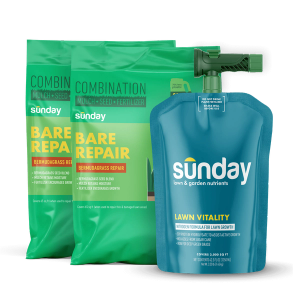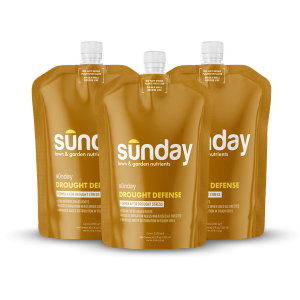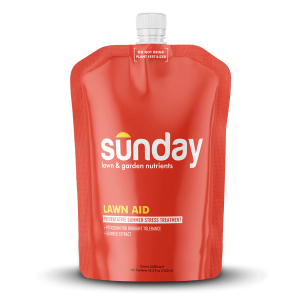5 steps to patching bare spots in your lawn
- Rake the patchy area well and pick up any leaves and debris to expose soil in the affected areas. Be sure to break up any clumpy soil.
- Scatter new grass seeds over the exposed soil. You can gently rake over the seeds to encourage good seed-to-soil contact.
- Spread about 1/4 inch of topdressing material (like compost, fine mulch, or topsoil!) over seeded areas.
- Water the seeds in the early morning and evening until they germinate, opting for your hose’s gentler setting. Be sure not to drench the area.
- Limit traffic on the newly seeded spots as much as possible. There's important stuff happening under the soil there! For best results, keep off until new grass is established.
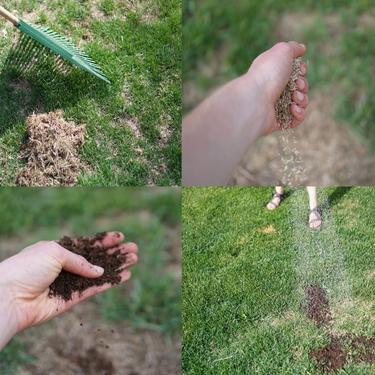
Sunday Tip:
If you know you have a St. Augustine lawn or other warm season grasses that don't grow well from seed, fill bare spots with sod or grass plugs instead.
Sunday can make it even easier
Our proprietary Bare Repair products are designed to help your grass grow back quickly and easily, featuring a cutting-edge blend of grass seed, nutrients, and organic moisture-holding mulch. Choose Bare Repair Bermudagrass for southern lawns, or Bare Repair Sun + Shade for northern and transitional lawns; both are available to add on to your lawn plan at anytime.
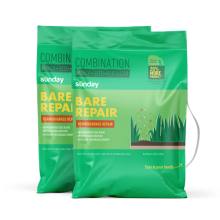
Bare Repair Bermudagrass (2-Pack)
- Two 4.5 lb. bags cover 130 sq. ft.
- Easy to use
- For existing Bermudagrass lawns
- Made without pesticides
- Works in 21 days or less
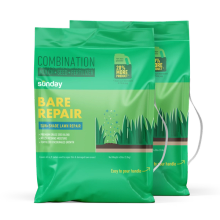
Bare Repair Sun + Shade Lawn Treatment + Grass Seed (2-pack)
- Two 4.5 lb. bags cover 130 sq. ft.
- Easy to use
- For any cool-season lawn
- Made without pesticides
- Works in 14 days or less
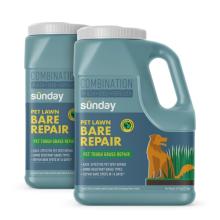
Pet Lawn Bare Repair (2-pack)
- Two 3.75 lb. jugs cover 110 sq. ft.
- Easy to use
- For any cool-season lawn
- Urine-resistant grass seed mix
- Works in 14 days or less
Why bare spots happen in your yard
Those patchy, bare spots in your lawn are often caused by fungi, pests, compacted soil, an excess of shade, or even mowing and watering habits (hey, it happens!). While reseeding helps, it's worth figuring out what's causing those patches in the first place.
- Dull mower blades: These will tear at your grass, causing damage and gradual death. So, sharpen those blades! After you mow, scope out the grass you cut to ensure your mower cut the yard cleanly.
- Cutting grass too short: Make sure your blades aren’t cutting the grass too short. It’s recommended you don’t cut more than ⅓ of grass bladed at a time.
- Dog urine: While patches in your yard can be caused by large birds, deer or other wildlife, dogs are the most common culprits. Start by ensuring your pooch is drinking enough water to dilute the nitrogen in their urine and make sure your lawn is getting watered too. If this persists, you may want to consult your vet. Nitrogen in dog urine comes from protein metabolism, so Fido might be better off eating a lower-protein diet.
- Poor soil: The quality of your soil is the key to everything, so make sure it’s not compacted or lacking nutrients by getting your soil lab tested. (Every Sunday Smart Lawn Plan comes with a complementary lab test.)
- Roots: Bushes or trees might make it hard for your grass to grow? Their roots compete for water and nutrients and their roots will win over your grass. Consider mulching under those areas since it can be quite difficult to grow grass near tree roots or under shrubs.
- Erosion: Not all yards are perfectly flat. Those with slopes may get dead patches more easily since water will run down the hillier areas, taking grass seeds and young shoots with it. Aeration could help increase water absorption. If your yard has a steep slope, consider building terraces or planting groundcover.
- Thatch: If you’ve got excessive thatch, you’ll get decaying grass. Quickest way to fix this is to dethatch your yard.
- Drought: Dry, compacted spots in your yard may be drought-damaged. The best thing you can do is to make sure water, from watering or rainfall, can reach the root system that’s past the topsoil. Aerate your entire lawn if the timing is right, and spot-aerate those dry, sunny spots.
- Chemicals: If fertilizer is applied unevenly or incorrectly, it can “burn” the grass, so be sure to follow the directions for application to the letter.
- Dormancy: While seasonal dormancy is normal (cold-season lawns in the summer heat, warm-season lawns in the winter), make sure your lawn is getting the nutrients it needs all year round to stay healthy and strong.
- Debris: It’s not a bad idea to double-check beneath the dried sod in dead patches that something isn’t buried there. Just to rule it out! Dead lumber, metal, old toys … these can all affect grass health.
- Insects: Grubs, chinch bugs and other pests can cause problems. You’ll want to take a microscopic look at those dry patches, checking under the sod for fat white worms, small bugs with white wings folded across their backs and other creepy crawlies that may be munching on grass blades. You can treat for grubs and other insects once you know what kind you’re dealing with.
- Fungal disease: Fungi often appears as circular or irregular brown spots in yards, so scope out the patches in your yard with a discerning eye. Be sure your lawn is getting the sunlight it needs, as most fungal diseases thrive in shade and moist conditions. You may need to call in an expert to help diagnose and treat lawn fungal disease.
So, got a turf that needs to be treated? If you’ve eliminated fungi, bugs, grubs, pests and other causes like thatch, you may just need some seeds. For one-on-one support patching bare spots and more, start your custom lawn plan!
Let's get growing
Our lawn engine uses satellite data to map out your lawn size and determine things like average rainfall, common weeds, and pest activity.











